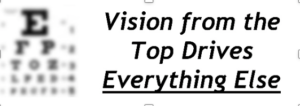 Many organizations get so caught up in what they currently do and how they do it, that they cannot find ways to effectively improve how they operate and experience the growth that stems from that kind of change. Plotting a path to organizational growth, especially based on the projects it chooses to execute, can be a challenge. The fundamental elements are not overly complicated, but the work to make the change is hard.
Many organizations get so caught up in what they currently do and how they do it, that they cannot find ways to effectively improve how they operate and experience the growth that stems from that kind of change. Plotting a path to organizational growth, especially based on the projects it chooses to execute, can be a challenge. The fundamental elements are not overly complicated, but the work to make the change is hard.
Stripping back the veneer of “pretend change” and finding how execution Value comes from properly communicated Vision and choices rooted in those fundamental elements often takes fresh eyes and a willingness to do things in a very different way. It can be a bit unnerving, but the alternative is stagnation.
Through this series of articles, we’ll highlight and discuss some of the fundamental elements that are necessary to effect real growth and improvement that is sustainable, and weed out the things that only add noise and distraction.
 Changing Course and Four Pillars
Changing Course and Four Pillars
In the previous article, we introduced what we termed “Four Pillars” that can be leveraged to change course toward growth and improvement and focused on the elements of Trust and Innovation. To really move forward, an organization needs to cast a clear Vision that shapes everything else that is done. Leveraging that Vision, you need to apply a framework and mindset (the one we’ll discuss happens to be Flow from Kallman AB) that ensures every initiative or project undertaken, especially in a critical period of intentional change, produces the intended Value as aligned to the Vision. Anything that fails to meet that criterion is probably a “science experiment” of some sort and needs to be carefully examined and, in most cases, stopped.
Back to Vision (or the Lack Thereof)
 In the first article, we brought up barriers to change that most organizations and individuals encounter. Among those barriers, we called out a “Lack of Vision” and used the old proverb about people perishing where they have no Vision to guide them. Organizations are the same way. If you see an organization that is failing (or has failed), chances are you can dig just under the surface and discover the leadership failed, often miserably, at casting and communicating a Vision that clearly framed out where the organization needed to go in order to succeed.
In the first article, we brought up barriers to change that most organizations and individuals encounter. Among those barriers, we called out a “Lack of Vision” and used the old proverb about people perishing where they have no Vision to guide them. Organizations are the same way. If you see an organization that is failing (or has failed), chances are you can dig just under the surface and discover the leadership failed, often miserably, at casting and communicating a Vision that clearly framed out where the organization needed to go in order to succeed.
Vision, as noted in the graphic at the beginning of the article, needs to be clear and consistent. It also needs to be communicated from the very top of an organization. Sure, team vision statements are great and they can go a long way toward productivity and success, but without that “master Vision” from the leadership, any change will be localized and limited at best.
The kind of Vision Andrew Kallman writes about in his book “Flow” isn’t a new concept by any stretch. In fact, Andrew and his late brother Ted (co-author of “Flow”) readily admit that the core principles, of which a strong Vision is one, have been around for a very long time. The problem usually comes from an organization failing to create that Vision in a clear fashion and consistently (and repeatedly) communicate that to everyone they are leading. The book notes case after case where the Vision was weak and/or miscommunicated, resulting in varying levels of frustration and failure. Some of those failures were severe enough to take a company down, if not completely then at least fundamentally.
From all this, we understand that Vision from the top is key to effective change that leads to growth and improvement. The Trust and Innovation we wrote about in the previous article are catalysts for the change, but without the foundation of Vision, they will meet with more challenges than successes. To play on the old proverb, a people given a clear Vision will find ways to elevate themselves and their organization to a higher maturity and greater success.
Fundamentals of Flow 101
There are many elements to Flow and more than a couple variations. For the purposes of this discussion, Flow is represented as a framework taking Vision, applying the “4-D Model” (from Kallman’s Flow), and connecting everything to Value. We’ve defined Vision well enough through this series, so we’ll set that aside for the moment as an assumed, existing element. Value, simply put, is the recognizable outcome (tangible or otherwise) that is a direct result of any initiative or project. Value as delivered is always tied directly to Vision.
To make the Vision work by producing Value and achieving Flow, you need the right People as part of the equation. This may sound simple and perhaps you might even react by saying “Of course!”; but there are nuances and considerations many organizations fail to take into account. Our earlier reference to Lencioni’s “Five Dysfunctions of a Team” bears strong consideration when determining what the “right people” for a given situation or organization look like. We emphasized the foundation of Trust in previous articles in this series.
Lencioni also wrote what is essentially a follow-up book titled “The Ideal Team Player” that builds on the themes from the earlier offering. In short, the model looks for characteristics in an individual that balance across the primary groupings of Humble, Hungry, and Smart. Discussing those metrics would take considerable time, but the ideal team player hits all three. In fact, if you find an individual lacking in more than one category, you may need to find other opportunities for said person (or suffer challenges that impede progress and Flow).
This brings us to the 4-D Model: Define, Distill, Deliver, and Drive. Again, expounding on each of these would require considerable space, but the essence of the four is as follows:
- Define – making sure every initiative the organization undertakes directly aligns the anticipated Value to be delivered with the Vision that has been cast by leadership. Further, this involves anything and everything that could be considered to be a definition, not just initiatives at the team level.
- Distill – spreading the Vision and gaining agreement constantly and consistently in a clear way so that nobody finds ambiguity in what they are doing or why.
- Deliver – focus on the Value results the Vision has set in motion.
- Drive – keep the teams and organization aligned and focused on the goal(s), then double-checking, in short iterations, that what is delivered at each step is in alignment with the clearly stated Vision.
 Applying this model won’t be without challenges. You will need to assess, adjust, and align (or re-align) along the way to ensure all the elements align and are working correctly. As noted in the graphic above, skipping any one of the components can result in getting sidetracked by everything from Anarchy to Confusion to Chaos. But if you have the discipline to consistently apply the model and make corrections to the deficiencies you uncover, you will find yourself moving closer and closer to a state of Flow that is not only sustainable, but repeatable in all your initiatives. Your choices will become clearer and the results you see will go a long way toward helping your organization move up the maturity model and tackle the harder challenges of the most substantive changes
Applying this model won’t be without challenges. You will need to assess, adjust, and align (or re-align) along the way to ensure all the elements align and are working correctly. As noted in the graphic above, skipping any one of the components can result in getting sidetracked by everything from Anarchy to Confusion to Chaos. But if you have the discipline to consistently apply the model and make corrections to the deficiencies you uncover, you will find yourself moving closer and closer to a state of Flow that is not only sustainable, but repeatable in all your initiatives. Your choices will become clearer and the results you see will go a long way toward helping your organization move up the maturity model and tackle the harder challenges of the most substantive changes
But Wait! There’s More!
We’ve now covered all four of the pillars that you need to consider if you are choosing to change. We’ve emphasized that a clear, cohesive Vision is critical to your journey toward improvement and higher levels of maturity. Without that Vision and the other fundamental elements we’ve discussed you may achieve some pockets of success, but it’s more likely you will experience conflict, anarchy, and Anti-Flow.
In the next article, we’ll wrap up this series by adding in the layers of Organizational Culture, a perspective from Flow Leadership known as the Four Lenses, and some encouragement to consider how to make change sustainable.
Bio
Mark Moore, M2PCC’s Executive Consultant, is an experienced leader and communicator, with a long track record of successful program and project management, training development and delivery, and transformational change. He brings over three decades of experience spanning multiple industries and disciplines. His focus on delivery of Value aligned with Vision lies at the heart of FLOW and organizational transformation.
Executive Consultant
mark@m2projectconsultingcorp.com
919.724.3679
